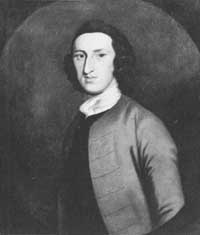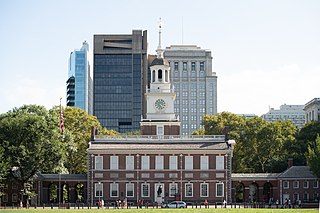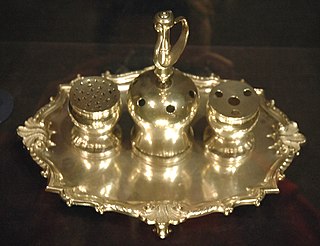Related Research Articles

Thomas McKean was an American lawyer, politician, and Founding Father. During the American Revolution, he was a Delaware delegate to the Continental Congress, where he signed the Continental Association, the United States Declaration of Independence, and the Articles of Confederation. McKean served as a President of Congress. He was at various times a member of the Federalist and the Democratic-Republican parties. McKean served as president of Delaware, chief justice of Pennsylvania, and the second governor of Pennsylvania. He is also known for holding copious public positions.

The United States Declaration of Independence, formally The unanimous Declaration of the thirteen united States of America, is the pronouncement and founding document adopted by the Second Continental Congress meeting at Pennsylvania State House, which was later renamed Independence Hall, in Philadelphia, Pennsylvania, on July 4, 1776. Enacted during the American Revolution, the Declaration explains why the Thirteen Colonies at war with the Kingdom of Great Britain regarded themselves as thirteen independent sovereign states and no longer subject to British colonial rule. With the Declaration, the 13 states took a collective first step in forming the United States and, de facto, formalized the American Revolutionary War, which had been ongoing since April 1775.

The Liberty Bell, previously called the State House Bell or Old State House Bell, is an iconic symbol of American independence, located in Philadelphia. Originally placed in the steeple of the Pennsylvania State House, the bell today is located across the street in the Liberty Bell Center in Independence National Historical Park. The bell was commissioned in 1752 by the Pennsylvania Provincial Assembly from the London firm of Lester and Pack, and was cast with the lettering "Proclaim LIBERTY Throughout all the Land unto all the Inhabitants Thereof", a Biblical reference from the Book of Leviticus. The bell first cracked when rung after its arrival in Philadelphia, and was twice recast by local workmen John Pass and John Stow, whose last names appear on the bell. In its early years, the bell was used to summon lawmakers to legislative sessions and to alert citizens about public meetings and proclamations.

1776 is a musical with music and lyrics by Sherman Edwards and a book by Peter Stone. The show is based on the events leading up to the signing of the Declaration of Independence, telling a story of the efforts of John Adams to persuade his colleagues to vote for American independence and to sign the document.

Charles Thomson was an Irish-born Patriot leader in Philadelphia during the American Revolution and the secretary of the Continental Congress (1774–1789) throughout its existence. As secretary, Thomson, a Founding Father of the United States, prepared the Journals of the Continental Congress, and his and John Hancock's names were the only two to appear on the first printing of the United States Declaration of Independence.

William Livingston was an American politician who served as the first governor of New Jersey (1776–1790) during the American Revolutionary War. As a New Jersey representative in the Continental Congress, he signed the Continental Association and the United States Constitution. He is considered one of the Founding Fathers of the United States and a Founding Father of New Jersey.

"Life, Liberty and the pursuit of Happiness" is a well-known phrase from the United States Declaration of Independence. The phrase gives three examples of the unalienable rights which the Declaration says have been given to all humans by their Creator, and which governments are created to protect. Like the other principles in the Declaration of Independence, this phrase is not legally binding, but has been widely referenced and seen as an inspiration for the basis of government.

Independence Hall is a historic civic building in Philadelphia, where both the United States Declaration of Independence and the United States Constitution were debated and adopted by America's Founding Fathers. The structure forms the centerpiece of the Independence National Historical Park and has been designated a UNESCO World Heritage Site.

John Dickinson, a Founding Father of the United States, was an attorney and politician from Philadelphia, Pennsylvania, and Wilmington, Delaware. Dickinson was known as the "Penman of the Revolution" for his twelve Letters from a Farmer in Pennsylvania, published individually in 1767 and 1768, and he also wrote "The Liberty Song" in 1768.

Andrew Allen was a lawyer and official from the Province of Pennsylvania. Born into an influential family, Allen initially favored the colonial cause in the American Revolution, and represented Pennsylvania in the Second Continental Congress from 1775 to 1776. Like many other wealthy elites in Pennsylvania, however, he resisted radical change, and became a Loyalist after the Declaration of Independence and the Pennsylvania Constitution of 1776.

Liberty Belle is the name of three superheroines. Two are from DC Comics: Libby Lawrence and Jesse Chambers, and the other is from Charlton Comics: Caroline Dean.

The Syng inkstand is a silver inkstand used during the signing of the United States Declaration of Independence in 1776 and the United States Constitution in 1787. Besides paper documents, it is one of four still-existing objects that were present during the Constitutional Convention, along with the Liberty Bell, the chair that George Washington sat in as the Constitutional Convention's presiding officer, and Independence Hall itself.

Independence National Historical Park is a federally protected historic district in Philadelphia, Pennsylvania that preserves several sites associated with the American Revolution and the nation's founding history. Administered by the National Park Service, the 55-acre (22 ha) park comprises many of Philadelphia's most-visited historic sites within the Old City and Society Hill neighborhoods. The park has been nicknamed "America's most historic square mile" because of its abundance of historic landmarks.

Pennsylvania was the site of many key events associated with the American Revolution and American Revolutionary War. The city of Philadelphia, then capital of the Thirteen Colonies and the largest city in the colonies, was a gathering place for the Founding Fathers who discussed, debated, developed, and ultimately implemented many of the acts, including signing the Declaration of Independence, that inspired and launched the revolution and the quest for independence from the British Empire.

A swivel, spinny, or revolving chair is a chair with a single central leg that allows the seat to rotate 360 degrees to the left or right. A concept of a rotating chair with swivel castors was illustrated by the Nuremberg patrician Martin Löffelholz von Kolberg in his 1505 technological illuminated manuscript, the so-called Codex Löffelholz, on folio 10r. It is purported that Thomas Jefferson drafted the United States Declaration of Independence in 1776 while sitting on a swivel chair of his own design.

1776 is a 1972 American musical drama film directed by Peter H. Hunt. The screenplay by Peter Stone was based on his book for the 1969 Broadway musical of the same name. Set in Philadelphia in the summer of 1776, it is a fictionalized account of the events leading up to the signing of the Declaration of Independence. The song score was composed by Sherman Edwards. The film stars William Daniels, Howard Da Silva, Donald Madden, John Cullum, Ken Howard and Blythe Danner.

Sons of the Revolution is a hereditary society which was founded in 1876 and educates the public about the American Revolution. The General Society Sons of the Revolution headquarters is a Pennsylvania non-profit corporation located at Williamsburg, Virginia. The Society is governed by a board of managers, an executive committee, officers, standing committees and their members, and staff. The General Society includes 28 State Societies and chapters in the United States, as well as Europe.

The Museum of the American Revolution is a museum in Philadelphia, Pennsylvania dedicated to telling the story of the American Revolution. The museum was opened to the public on April 19, 2017, the 242nd anniversary of the first battles of the war, at Lexington and Concord, on April 19, 1775.

The Justice Bell is a replica of the Liberty Bell made in 1915. It was created to promote the cause for women's suffrage in the United States from 1915 to 1920. The bell is on permanent display at the Washington Memorial Chapel in Valley Forge National Park in Pennsylvania.
Hercules Mulligan was an Irish-American tailor and spy during the American Revolutionary War. He was a member of the Sons of Liberty.
References
- ↑ Archived November 20, 2005, at the Wayback Machine
- ↑ Society, American Philosophical (1884). Early Proceedings of the American Philosophical Society for the Promotion of Useful Knowledge. Press of McCalla & Stavely. p. 12.
Andrew McNair.
- ↑ "Aisle Say (NY): 1776". aislesay.com. Retrieved 2015-04-04.
- ↑ Whipple, Wayne (1910). The Story of the Liberty Bell. Henry Altemus Company. p. 122.
Andrew McNair.
- ↑ "The Genealogue: It Didn't Have the Ring of Truth". genealogue.com. Retrieved 2015-04-04.